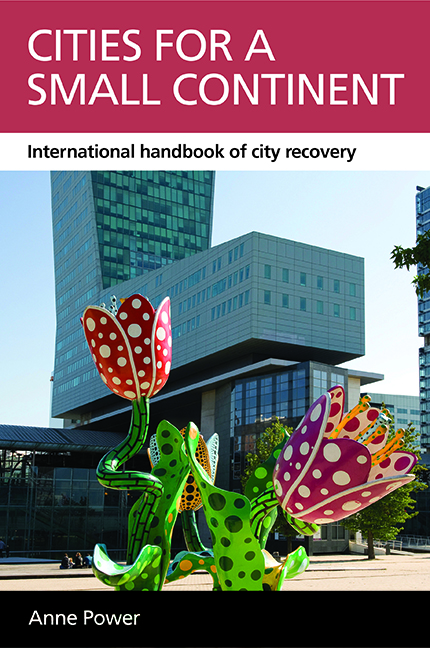Book contents
- Frontmatter
- Contents
- List of tables and figures
- Abbreviations and acronyms
- Acknowledgements
- Copyright material
- Foreword
- one Lessons from cities in a crowded continent Tale of a city – Bilbao
- two Divided and united Europe Tale of a city – Belfast
- three Grit and vision Tale of a city – Sheffield
- four Struggle and strive Tale of a city – Lille
- five Threats and opportunities Tale of a city – St Étienne
- six Over-scale and under-scale Tale of a city – Torino
- seven The power of social innovation Tale of a city – Leipzig
- eight Shoots of growth in older industrial cities in the US Tale of a city – Detroit
- nine Finding new ways out of the woods
- Endnotes
- References
- Afterword
- La Fabrique de la Cité
- Index
Foreword
Published online by Cambridge University Press: 01 September 2022
- Frontmatter
- Contents
- List of tables and figures
- Abbreviations and acronyms
- Acknowledgements
- Copyright material
- Foreword
- one Lessons from cities in a crowded continent Tale of a city – Bilbao
- two Divided and united Europe Tale of a city – Belfast
- three Grit and vision Tale of a city – Sheffield
- four Struggle and strive Tale of a city – Lille
- five Threats and opportunities Tale of a city – St Étienne
- six Over-scale and under-scale Tale of a city – Torino
- seven The power of social innovation Tale of a city – Leipzig
- eight Shoots of growth in older industrial cities in the US Tale of a city – Detroit
- nine Finding new ways out of the woods
- Endnotes
- References
- Afterword
- La Fabrique de la Cité
- Index
Summary
Cities have entranced me all my life. I love the life of cities, their surprises of form and activity, of buildings and people, of constant change.
I particularly love the best European cities for their density, their mixed use and their compact form. Barcelona, where I was architectural advisor during the Olympic period, is an amazing example. Yet it was deeply decayed after 40 years of dictatorship; its port was in steep decline; it had acres of scarred land; there were concentrations of extreme poverty in settlements on the periphery. But Barcelona had the life and mix of uses that many port cities exhibit; the very centre of the city was and still is crowded with immigrants from Africa mixed with traditional fishing communities. A succession of mayors with a powerful vision for the city helped it regain its former glory as the self-styled ‘Capital of the Mediterranean’.
Barcelona's story exemplifies the strengths and challenges of Europe's industrial cities, former giants in the global economy, but left with vast dereliction, extraordinary levels of unemployment and devastating environmental damage. It is all too easy to spoil our cities. A combination of poor design, harsh social divisions, weakened economies, massive congestion, noise, dirt and total disregard for the environment has left many of them struggling to find a new future.
But Europe is a continent with an amazing urban history, resilient local leadership and citizenry, and imposing industrial architecture. Through a revival of local democracy and decentralisation, extraordinary energy was unleashed in Barcelona and through many small steps, a huge vision was delivered. This applies in different ways to the European cities this book is about.
Fifteen years ago, Anne Power and I wrote Cities for a Small Country, following our work together on the Urban Task Force. We argued that Britain, as an island, had no choice but to care for its cities, to run them differently, to stop sprawl and to concentrate on compact reuse. This required a very different approach to city reclamation, encompassing environmental protection, land use, buildings, design and social integration. Now Cities for a Small Continent takes up the baton for Europe's older industrial cities.
- Type
- Chapter
- Information
- Cities for a Small ContinentInternational Handbook of City Recovery, pp. xv - xviPublisher: Bristol University PressPrint publication year: 2016

